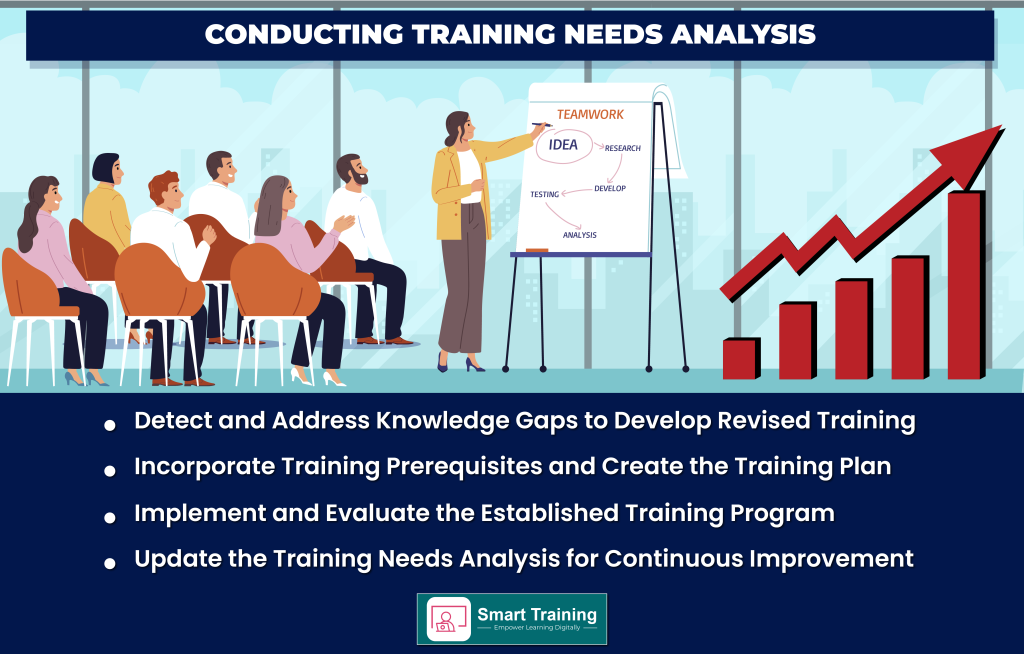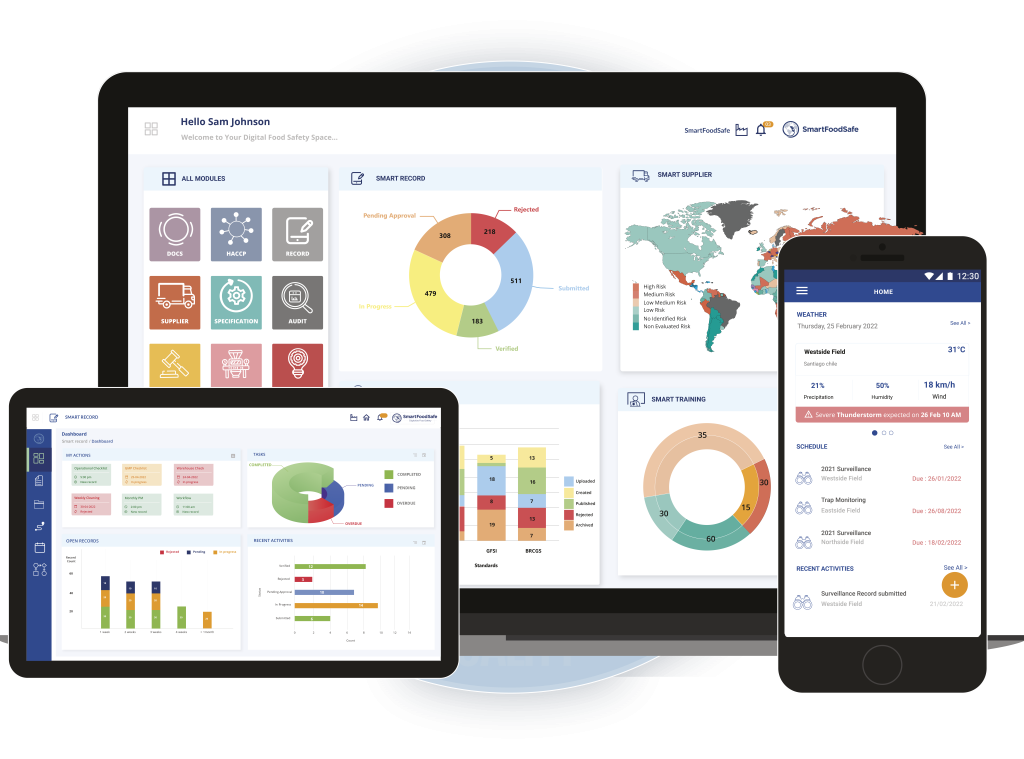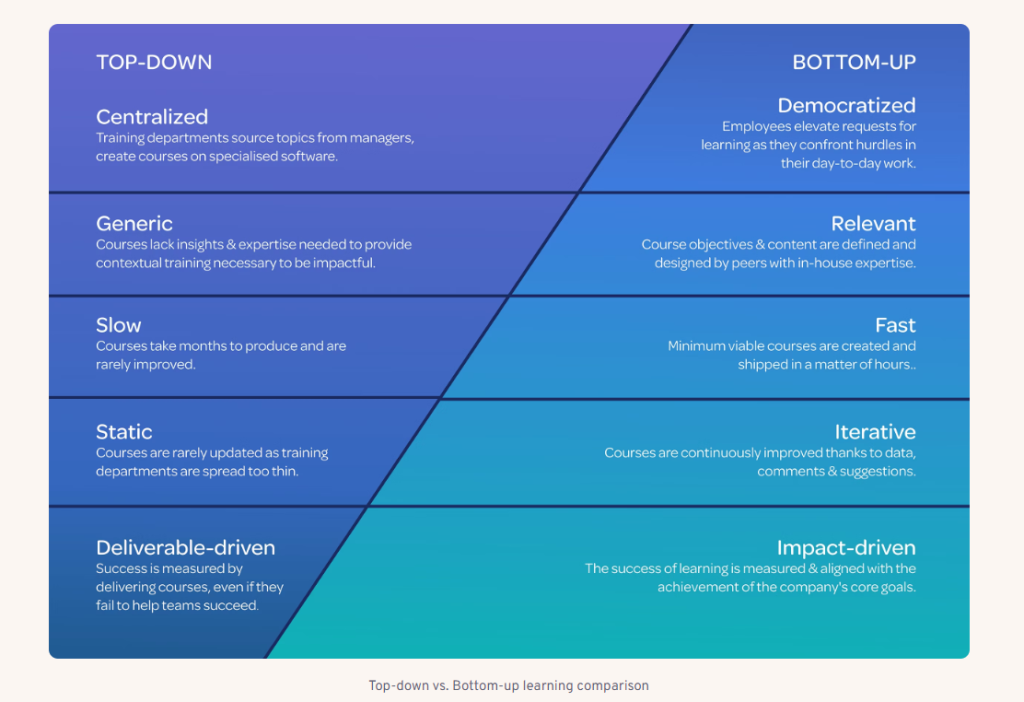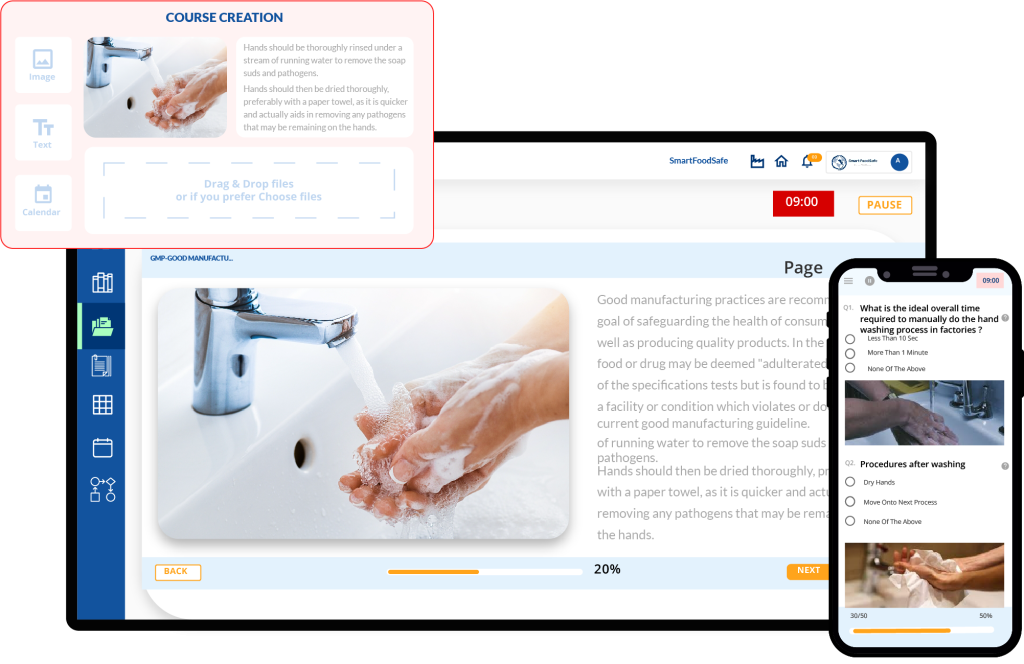


Companies are 17% more productive and 21% more profitable when they offer comprehensive and engaging training to employees, as per a 2023 global survey on employee training statistics.
Employee training must be a deliberate investment while running a business that demands a return. This underscores the strategic importance of determining the who, when, and how of training. And what is the key to making strategic training decisions? Conducting training needs analysis.
A training needs analysis involves gauging individuals’ current competencies in various areas and comparing these against the established competency standards for their roles or other positions in the company. This comparison highlights gaps between existing skills and the required standards, aiding in identifying necessary training. Rather than assuming a universal training need for all employees, this method empowers management to make informed decisions on addressing specific competency gaps among individuals, job categories, or teams.
These assessments aren’t bound by specific timings but are often conducted post-hiring, during performance evaluations, when performance enhancement is sought, for career growth plans, during succession planning, or when organizational changes affect job roles. Periodic assessments prove beneficial, offering insights into the organization’s training needs, employees’ skill levels, and the effectiveness of training programs.
Training needs analysis offers a well-rounded perspective on the various factors impacting required training and its reception, aiding in constructing a more streamlined and powerful training solution for your workforce. The following are some reasons for why training needs analysis can bring favorable consequences for an organization’s upliftment:
The training needs analysis process yields comprehensive data detailing the specific training requirements, facilitating curated adequate courses and their delivery to each team or employee. When content directly relates to an employee’s role, engagement in learning increases, subsequently boosting the efficiency of the training program.
A training needs analysis detects skill gaps and pinpoints the precise knowledge and skills requisite for employees to enhance their productivity and innovation in their roles, mainstreaming training initiatives that can positively influence the company’s bottom line. By improving their performance, employees directly contribute to fulfilling the company’s objectives, especially by becoming invaluable in the face of time or budget constraints.
Incorporating surveys, observations, and diverse evaluations during training needs analysis not only reveals existing learning hurdles but also unveils unexplored training methodologies. For instance, if surveys reveal that traditional classroom workshops impede daily responsibilities and cause stress among employees, adopting an LMS (Learning Management System) enabling flexible, self-paced learning might be the solution.
Training decisions based on measurable skill gaps tend to result in substantial learning and performance improvement, epitomizing the coveted return on training investment. Moreover, this assessment enables for evaluation of the efficacy of previous training initiatives. Tangible evidence of training effectiveness solidifies its credibility among stakeholders and justifies the training budget.
Reports indicate that employees who perceive their input is valued by employers are nearly five times more inclined to perform at their best. A training needs analysis becomes a vehicle to convey this acknowledgment. When employees’ expressed needs translate into visible actions, like adopting a more digital training approach, it reinforces their belief that the company values their input. These assessment results aid managers devise tailored development paths and succession plans, creating a mutually beneficial scenario.
Change is inevitable, particularly in the business landscape. Whether it involves adopting new software, restructuring departments, or redefining strategic vision, change is constant. Training holds the answer for employees to prepare for these transitions effectively according to the different circumstances. For instance, cultivating a customer-centric culture might require training in customer service and soft skills, while adapting to a new training platform might necessitate technical training.
Executing training needs analysis involves a systematic approach to identifying gaps in knowledge, skills, or abilities within an organization and determining the most effective solutions to address these gaps. Rather than following the conventional top-down method where managers or learning and development departments evaluate training needs and generate course materials, embrace a bottom-up approach by allowing employees to articulate what they look forward to learning to function better.
Boost your food business’s hygiene standards with Smart Food Safe’s tech-driven solutions—streamline 4C processes to yield optimal results, and ensure compliance effortlessly.

Boost your food business’s hygiene standards with Smart Food Safe’s tech-driven solutions—streamline 4C processes to yield optimal results, and ensure compliance effortlessly.

Training needs analysis with such an agenda encompasses the following steps:
Begin by understanding why a training program is needed. Define the organizational objectives, ensuring alignment with the intended outcomes of the training. Identify specific knowledge, skills, and abilities (KSAs) and define measurable Key Performance Indicators (KPIs) that will gauge the success of the training initiative.
Conduct a thorough assessment of existing conditions within the organization. Gather data from various sources like employee interviews, surveys, observations, and assessments. This step involves understanding not only existing skills but also uncovering underlying issues that may not be resolved solely through training. Engage with frontline workers, supervisors, and managers to gather diverse perspectives on the situation. Gather feedback from employees regarding the current training methods, materials, and resources. Determine what aspects of existing training are beneficial and what needs improvement or modification.
Based on the analysis, identify the gaps between the current and desired state of knowledge, skills, and abilities. Determine the specific areas where training is needed and the nature of these training requirements. Consider alternative solutions beyond training if the issues go beyond skill gaps. Develop a comprehensive plan that outlines what needs to change, who needs training, and how it should be delivered.
Create a detailed plan outlining the necessary training programs, their goals, content, delivery methods, and the target audience. Determine whether the training will be conducted in-house or externally and whether it will be synchronous or asynchronous. Consider the learning styles and preferences of participants, and ensure the training plan aligns with the organization’s resources and capabilities. Schedule accordingly and prioritize based on the urgency of results from employees and the sequence required for training prerequisites.
Undertake the training plan and regularly assess its capability through feedback mechanisms, KPIs, and post-training assessments. Continuously refine the training programs based on feedback and changing organizational needs.
Regularly revisit and update the training needs analysis to ensure it remains aligned with evolving organizational goals and changes in the industry landscape. A training needs analysis is an iterative process that requires ongoing evaluation and adjustment to ensure it remains competent in supporting the organization’s targets.
Challenge 1: Data Collection & Analysis
Acquiring data from diverse sources like performance management systems, surveys, and interviews can be complex. Ensuring the data’s reliability and relevance poses a challenge. Moreover, manually analyzing vast datasets can be time-consuming and prone to errors.
Overcoming with Tech-Enabled Best Practices
Utilize data aggregation tools and AI algorithms to collect, process, and analyze data from performance management systems, surveys, interviews, and more. AI-driven analytics can swiftly process vast datasets, ensuring accuracy and uncovering hidden patterns.
Implement Learning Management Systems (LMS) and data visualization tools to structure the TNA process systematically. LMS can facilitate communication, track learner progress, and offer tailored learning paths. Advanced analytics in these systems provide insights into learner behaviors and preferences, aiding in personalized training programs.
Challenge 2: Prioritization & Alignment
Identifying and aligning specific training needs with broader organizational objectives can be challenging. It requires a structured approach to prioritize needs in a way that reflects and supports the overarching goals of the organization. Gaining consensus and involvement from stakeholders in this process can also be intricate.
Overcoming with Tech-Enabled Best Practices
Utilize software that aligns training needs analysis with organizational objectives. AI-driven decision support systems can help prioritize needs based on criteria set by the organization, ensuring coherence across different levels. Implement collaborative platforms and decision-making tools that involve stakeholders in the prioritization process. Training management software facilitates collaborative decision-making, allowing stakeholders to contribute insights and rank training needs based on established criteria.
Challenge 3: Execution & Review
After identifying needs and designing training solutions, ensuring their successful execution and comprehending their effectiveness pose challenges. Assessing the impact of these solutions and continuously refining them based on learner feedback and performance data is critical but can be demanding.
Overcoming with Tech-Enabled Best Practices
Shift to learning technologies like Virtual Classrooms, Augmented Reality (AR), or VR for immersive learning experiences. These technologies simulate hands-on scenarios, enhancing engagement and learning retention. Also, Learning Experience Platforms (LXP) offer adaptive learning paths, tailoring content based on learner feedback and performance data.
Employ adaptive learning algorithms within learning platforms to personalize content delivery based on learner preferences and progress. Reporting analytics track learner performance and behavior, providing actionable insights for improvement and aiding in refining future programs.
Looking Ahead
Integrating technology and digitalization to drive optimal results in conducting training needs analysis can streamline data collection, enhance decision-making, personalize learning experiences, and improve overall effectiveness and efficiency in addressing the challenges of training needs analysis. A learning management system (LMS) can be the tool that can be a game-changer in this context to enable robust content delivery, progress tracking, assessing productiveness, and optimizing the training process by offering personalized learning experiences based on individual requirements as part of the training needs analysis.
For modern enterprises seeking an adaptable learning management system that seamlessly blends with their unique business needs, Smart Training stands as the quintessential solution. Smart Training emerges not merely as a learning management tool but as a promoter for revolutionizing organizational training ecosystems. Its multifaceted features, including course creation, self and group learning, integrated assessments, and skill matrix management, converge to elevate the training process in accordance with the training needs analysis.
Unlocking Flexibility and Accessibility
One of the standout features of Smart Training lies in its capacity to bridge geographical barriers. Its cloud-based accessibility ensures easy and convenient access to training materials from any location and time zone. This particularly benefits remote teams, enabling seamless participation in training programs irrespective of physical boundaries.
Customized Learning for Enhanced Engagement
The customization prowess of Smart Training empowers organizations to tailor training content to suit individual job roles, skill sets, and diverse learning styles. By fostering collaborative learning environments, it fosters increased engagement among employees, trainers, and managers, thereby significantly enhancing learning outcomes.
Empowering Progress through Real-Time Insights
Real-time tracking and reporting functionalities embedded within Smart Training enable organizations to monitor training progress comprehensively. This capability allows for the swift identification of areas requiring additional focus, ensuring that employees receive the necessary training to excel in their roles effectively.

Companies are 17% more productive and 21% more profitable when they offer comprehensive and engaging training to employees, as per a 2023 global survey on employee training statistics.
Employee training must be a deliberate investment while running a business that demands a return. This underscores the strategic importance of determining the who, when, and how of training. And what is the key to making strategic training decisions? Conducting training needs analysis.
A training needs analysis involves gauging individuals’ current competencies in various areas and comparing these against the established competency standards for their roles or other positions in the company. This comparison highlights gaps between existing skills and the required standards, aiding in identifying necessary training. Rather than assuming a universal training need for all employees, this method empowers management to make informed decisions on addressing specific competency gaps among individuals, job categories, or teams.
These assessments aren’t bound by specific timings but are often conducted post-hiring, during performance evaluations, when performance enhancement is sought, for career growth plans, during succession planning, or when organizational changes affect job roles. Periodic assessments prove beneficial, offering insights into the organization’s training needs, employees’ skill levels, and the effectiveness of training programs.
Training needs analysis offers a well-rounded perspective on the various factors impacting required training and its reception, aiding in constructing a more streamlined and powerful training solution for your workforce. The following are some reasons for why training needs analysis can bring favorable consequences for an organization’s upliftment:
The training needs analysis process yields comprehensive data detailing the specific training requirements, facilitating curated adequate courses and their delivery to each team or employee. When content directly relates to an employee’s role, engagement in learning increases, subsequently boosting the efficiency of the training program.
A training needs analysis detects skill gaps and pinpoints the precise knowledge and skills requisite for employees to enhance their productivity and innovation in their roles, mainstreaming training initiatives that can positively influence the company’s bottom line. By improving their performance, employees directly contribute to fulfilling the company’s objectives, especially by becoming invaluable in the face of time or budget constraints.
Incorporating surveys, observations, and diverse evaluations during training needs analysis not only reveals existing learning hurdles but also unveils unexplored training methodologies. For instance, if surveys reveal that traditional classroom workshops impede daily responsibilities and cause stress among employees, adopting an LMS (Learning Management System) enabling flexible, self-paced learning might be the solution.
Training decisions based on measurable skill gaps tend to result in substantial learning and performance improvement, epitomizing the coveted return on training investment. Moreover, this assessment enables for evaluation of the efficacy of previous training initiatives. Tangible evidence of training effectiveness solidifies its credibility among stakeholders and justifies the training budget.
Reports indicate that employees who perceive their input is valued by employers are nearly five times more inclined to perform at their best. A training needs analysis becomes a vehicle to convey this acknowledgment. When employees’ expressed needs translate into visible actions, like adopting a more digital training approach, it reinforces their belief that the company values their input. These assessment results aid managers devise tailored development paths and succession plans, creating a mutually beneficial scenario.
Change is inevitable, particularly in the business landscape. Whether it involves adopting new software, restructuring departments, or redefining strategic vision, change is constant. Training holds the answer for employees to prepare for these transitions effectively according to the different circumstances. For instance, cultivating a customer-centric culture might require training in customer service and soft skills, while adapting to a new training platform might necessitate technical training.
Executing training needs analysis involves a systematic approach to identifying gaps in knowledge, skills, or abilities within an organization and determining the most effective solutions to address these gaps. Rather than following the conventional top-down method where managers or learning and development departments evaluate training needs and generate course materials, embrace a bottom-up approach by allowing employees to articulate what they look forward to learning to function better.
Boost your food business’s hygiene standards with Smart Food Safe’s tech-driven solutions—streamline 4C processes to yield optimal results, and ensure compliance effortlessly.


Training needs analysis with such an agenda encompasses the following steps:
Begin by understanding why a training program is needed. Define the organizational objectives, ensuring alignment with the intended outcomes of the training. Identify specific knowledge, skills, and abilities (KSAs) and define measurable Key Performance Indicators (KPIs) that will gauge the success of the training initiative.
Conduct a thorough assessment of existing conditions within the organization. Gather data from various sources like employee interviews, surveys, observations, and assessments. This step involves understanding not only existing skills but also uncovering underlying issues that may not be resolved solely through training. Engage with frontline workers, supervisors, and managers to gather diverse perspectives on the situation. Gather feedback from employees regarding the current training methods, materials, and resources. Determine what aspects of existing training are beneficial and what needs improvement or modification.
Based on the analysis, identify the gaps between the current and desired state of knowledge, skills, and abilities. Determine the specific areas where training is needed and the nature of these training requirements. Consider alternative solutions beyond training if the issues go beyond skill gaps. Develop a comprehensive plan that outlines what needs to change, who needs training, and how it should be delivered.
Create a detailed plan outlining the necessary training programs, their goals, content, delivery methods, and the target audience. Determine whether the training will be conducted in-house or externally and whether it will be synchronous or asynchronous. Consider the learning styles and preferences of participants, and ensure the training plan aligns with the organization’s resources and capabilities. Schedule accordingly and prioritize based on the urgency of results from employees and the sequence required for training prerequisites.
Undertake the training plan and regularly assess its capability through feedback mechanisms, KPIs, and post-training assessments. Continuously refine the training programs based on feedback and changing organizational needs.
Regularly revisit and update the training needs analysis to ensure it remains aligned with evolving organizational goals and changes in the industry landscape. A training needs analysis is an iterative process that requires ongoing evaluation and adjustment to ensure it remains competent in supporting the organization’s targets.
Challenge 1: Data Collection & Analysis
Acquiring data from diverse sources like performance management systems, surveys, and interviews can be complex. Ensuring the data’s reliability and relevance poses a challenge. Moreover, manually analyzing vast datasets can be time-consuming and prone to errors.
Overcoming with Tech-Enabled Best Practices
Utilize data aggregation tools and AI algorithms to collect, process, and analyze data from performance management systems, surveys, interviews, and more. AI-driven analytics can swiftly process vast datasets, ensuring accuracy and uncovering hidden patterns.
Implement Learning Management Systems (LMS) and data visualization tools to structure the TNA process systematically. LMS can facilitate communication, track learner progress, and offer tailored learning paths. Advanced analytics in these systems provide insights into learner behaviors and preferences, aiding in personalized training programs.
Challenge 2: Prioritization & Alignment
Identifying and aligning specific training needs with broader organizational objectives can be challenging. It requires a structured approach to prioritize needs in a way that reflects and supports the overarching goals of the organization. Gaining consensus and involvement from stakeholders in this process can also be intricate.
Overcoming with Tech-Enabled Best Practices
Utilize software that aligns training needs analysis with organizational objectives. AI-driven decision support systems can help prioritize needs based on criteria set by the organization, ensuring coherence across different levels. Implement collaborative platforms and decision-making tools that involve stakeholders in the prioritization process. Training management software facilitates collaborative decision-making, allowing stakeholders to contribute insights and rank training needs based on established criteria.
Challenge 3: Execution & Review
After identifying needs and designing training solutions, ensuring their successful execution and comprehending their effectiveness pose challenges. Assessing the impact of these solutions and continuously refining them based on learner feedback and performance data is critical but can be demanding.
Overcoming with Tech-Enabled Best Practices
Shift to learning technologies like Virtual Classrooms, Augmented Reality (AR), or VR for immersive learning experiences. These technologies simulate hands-on scenarios, enhancing engagement and learning retention. Also, Learning Experience Platforms (LXP) offer adaptive learning paths, tailoring content based on learner feedback and performance data.
Employ adaptive learning algorithms within learning platforms to personalize content delivery based on learner preferences and progress. Reporting analytics track learner performance and behavior, providing actionable insights for improvement and aiding in refining future programs.
Looking Ahead
Integrating technology and digitalization to drive optimal results in conducting training needs analysis can streamline data collection, enhance decision-making, personalize learning experiences, and improve overall effectiveness and efficiency in addressing the challenges of training needs analysis. A learning management system (LMS) can be the tool that can be a game-changer in this context to enable robust content delivery, progress tracking, assessing productiveness, and optimizing the training process by offering personalized learning experiences based on individual requirements as part of the training needs analysis.
For modern enterprises seeking an adaptable learning management system that seamlessly blends with their unique business needs, Smart Training stands as the quintessential solution. Smart Training emerges not merely as a learning management tool but as a promoter for revolutionizing organizational training ecosystems. Its multifaceted features, including course creation, self and group learning, integrated assessments, and skill matrix management, converge to elevate the training process in accordance with the training needs analysis.
Unlocking Flexibility and Accessibility
One of the standout features of Smart Training lies in its capacity to bridge geographical barriers. Its cloud-based accessibility ensures easy and convenient access to training materials from any location and time zone. This particularly benefits remote teams, enabling seamless participation in training programs irrespective of physical boundaries.
Customized Learning for Enhanced Engagement
The customization prowess of Smart Training empowers organizations to tailor training content to suit individual job roles, skill sets, and diverse learning styles. By fostering collaborative learning environments, it fosters increased engagement among employees, trainers, and managers, thereby significantly enhancing learning outcomes.
Empowering Progress through Real-Time Insights
Real-time tracking and reporting functionalities embedded within Smart Training enable organizations to monitor training progress comprehensively. This capability allows for the swift identification of areas requiring additional focus, ensuring that employees receive the necessary training to excel in their roles effectively.

Signup to receive latest news, insights and updates on training management